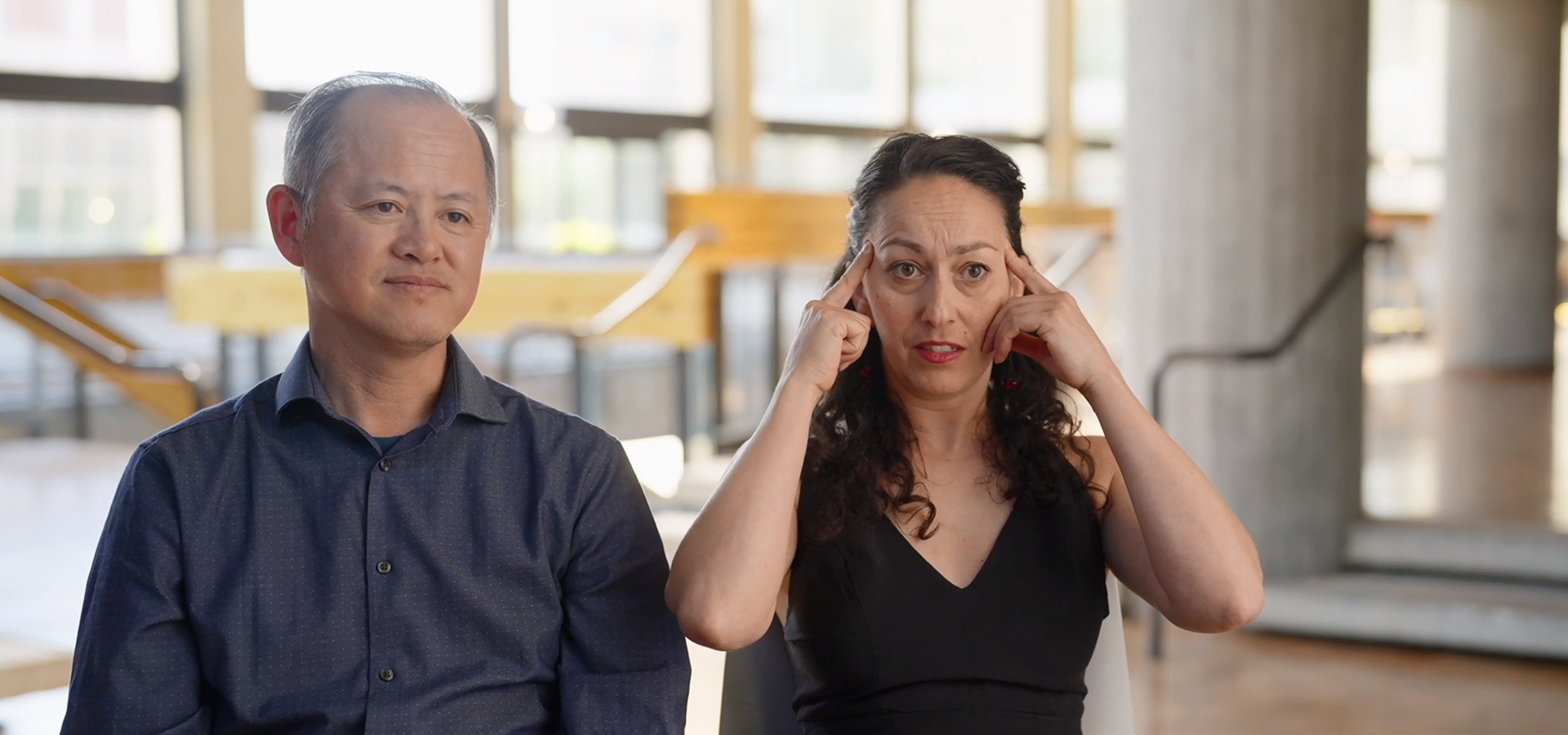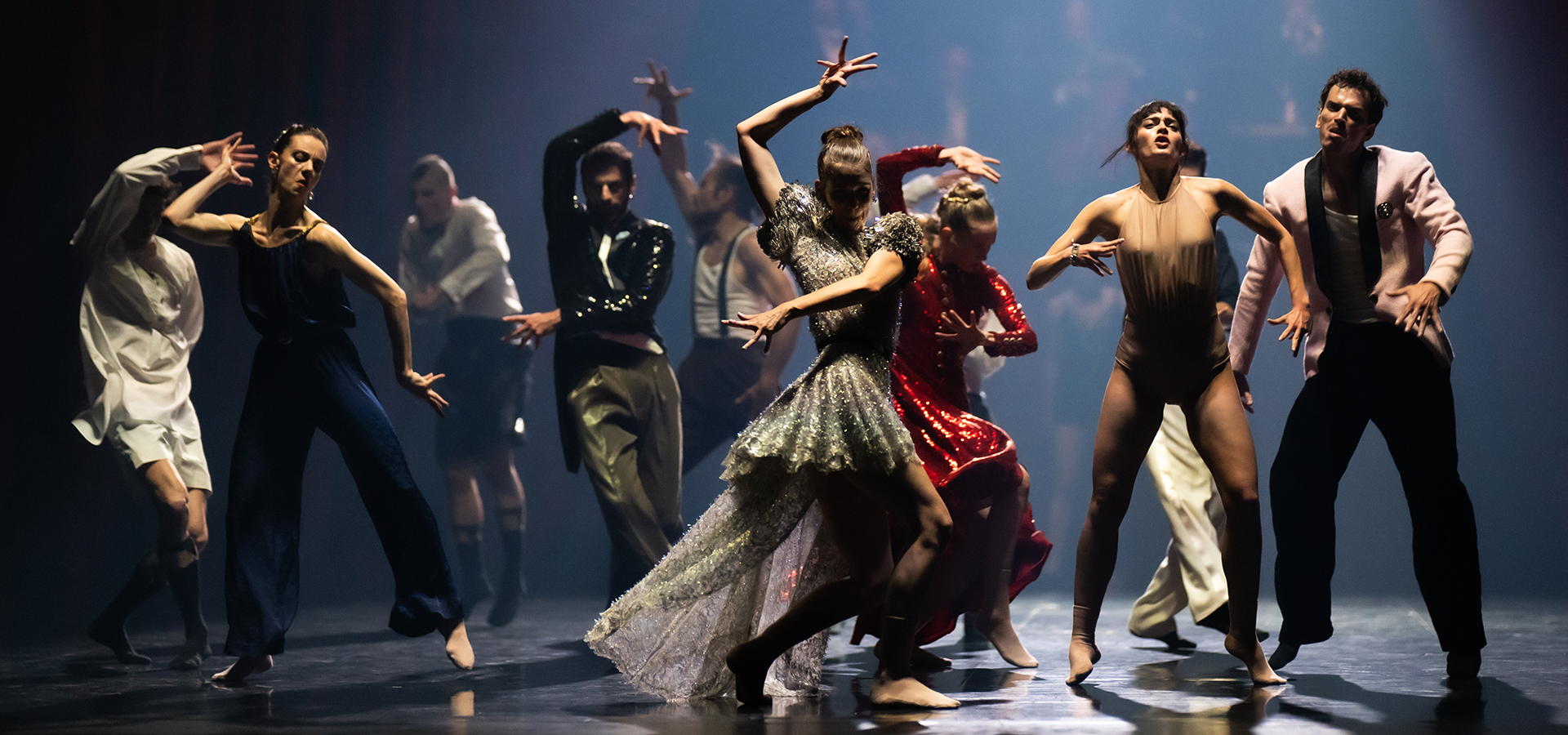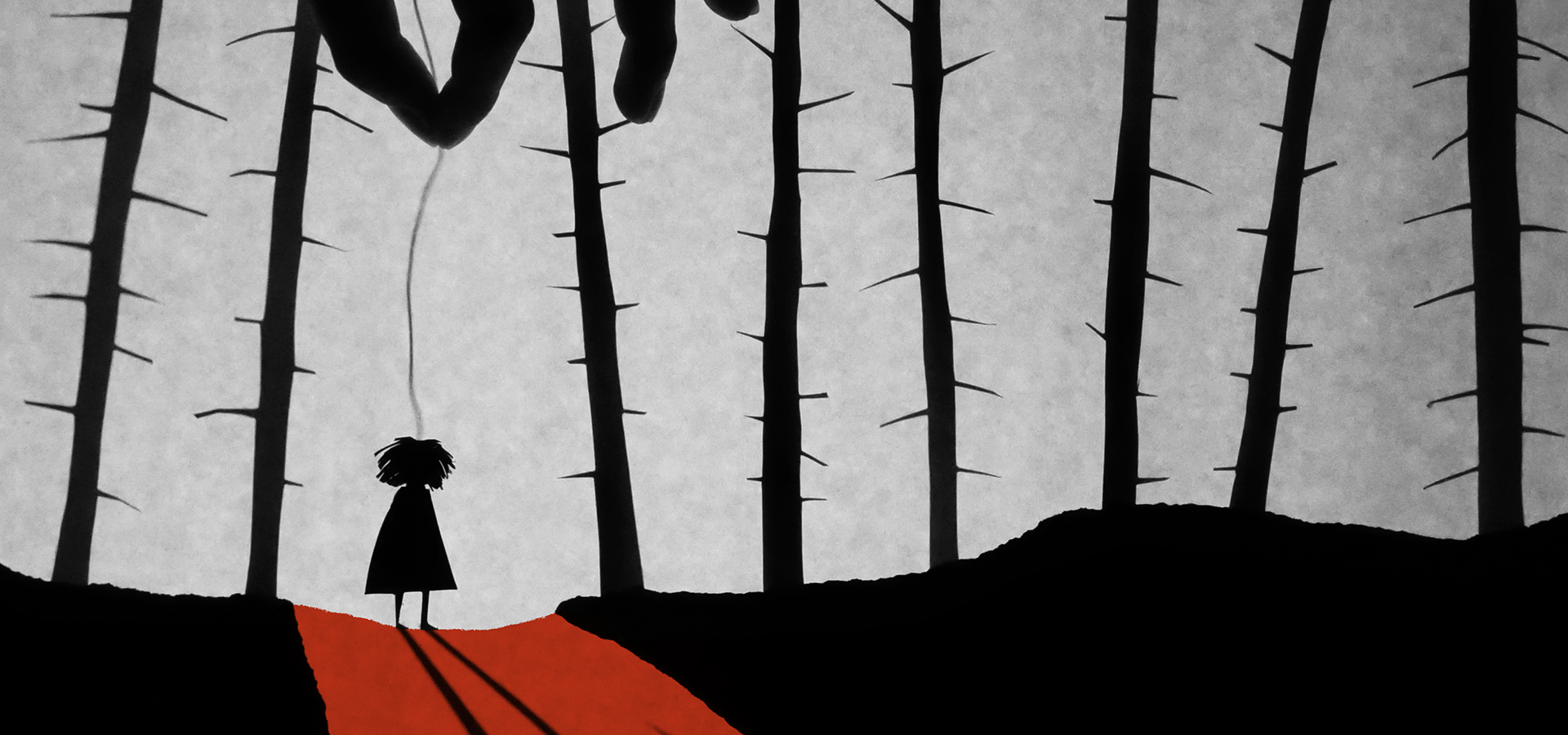
“Human and Machine”: Technology and Creative Expression
The machines that have worked with—and against—artistic expression and communication.
Featuring 2022/23 Illuminations artists Steve Reich, Sō Percussion, and Michel van der Aa, plus Kinetech Arts.
In this first of three videos expounding on the 2022/23 “Human and Machine” Illuminations theme, we asked Illuminations artists and thought leaders about how technology has and continues to shape their artistic process, output, and creativity.
Transcript
Jason Treuting (Sō Percussion):
These drum machines get faster and faster and faster, and the drummer’s job is to play with them until it’s just physically impossible.
Steve Reich:
But what’s amazing is this process, this journey of starting in unison and then gradually coming apart, informing these all kinds of counterpointed relations, some of which are rational, some of which are very irrational.
Michel van der Aa:
There’s so much technology around us, you know, on our phones and our watches, and for me, it would feel very artificial to not allow that on stage.
Daiane Lopes da Silva (Kinetech Arts):
I always joke that I’m the human and he’s the machine.
Weidong Yang (Kinetech Arts):
What can I do? Yeah.
Jason Treuting (Sō Percussion):
I feel like Dan Trueman’s “neither Anvil nor Pulley” encapsulates so many of the ways we think about the kind of organic approach and the technology approach. This piece is in five movements and the first, third, and fifth are these folk songs. And Dan’s a hardanger fiddle player, and they’re very organic and very fluid. We have choices over what sounds we’re playing, and in the two and four slot are these large pieces that are really technology driven. I’ve started to think about them as the second one is a little bit like humans with technology, you know, we are in control of this technology and using it to play music together and it’s helping us do some things that we couldn’t do. Otherwise, we’re also responding to it. It’s really kind of fluid. The fourth one, I feel like that gets more into a human against technology and, depending on the night, it’s hard to know who wins. I think the humans win in the end, you know, but these drum machines get faster and faster and faster and the drummer’s job is to play with them until it’s just physically impossible. And so then you have a choice. Are you gonna try to keep playing with this machine, or are you gonna just do your own thing and, for me sitting in the drummer spot, if I have the energy, I try to do my own thing and come out, you know, come out on top.
Eric Cha-Beach (Sō Percussion):
What I was thinking about in terms of maybe one of the times where we did a little bit more exploration of what the boundary was was in Nathalie Joachim’s piece because the samples we’re playing on the sampler pad are her voice. So, hypothetically, she could sing all of those things; or, hypothetically, you could program them all and just have the computer play it back perfectly; or someone could play it at a MIDI keyboard.
And I think the reason we settled on the SPD is that it was a combination of her sound world in her head and then our skills as percussionists. So we’ve just trained to move our hands in a particular way and we can trigger those samples using the skills that we have as percussionists, and what, we what we get to actually does sound different than triggering those samples on a keyboard or just having it MIDI-mapped.
We start to drum and we start to groove with the way that we drum, and now her voice samples are coming out in a, in a groove that’s just different because it’s being played by drummers. So that, to me, was sort of letting the technology and the execution of that technology find a different musical end result. Not that, you know, very similar, but different feeling results could have been done in other ways.
Daiane Lopes da Silva (Kinetech Arts):
There’s some things that I did with technology that I couldn’t just do myself. It really opens up your brain to many different possibilities. And this happened many, you know, many, many years ago. Already Cunningham was doing that. He was using technology to create movement that he wasn’t, he would never ever thought about. And I think that technology does that a lot.
Weidong Yang (Kinetech Arts):
Like we joke about before we start, that she’s the human, I’m the machine; and when we work together, I often come up with the technologies, so the things that we want to explore. As an engineer, as a scientist, I often get carried away with those gadgets, but it’s usually, it’s the have to wait to get to her hands, and then I start to say, ‘Oh, that’s kind of a nuts’.
Daiane Lopes da Silva (Kinetech Arts):
In the beginning when we started Kinetech Arts in 2013, we were also excited about these new toys, these new gadgets, and everything became about the technology, and I was like, ‘Oh my God, we are all like—I’m looking from the outside in the lab, and we’re all like a zombies,’ like I was like, this doesn’t feel right. This is not—you feel like we need to really go deeper into, ‘What is that about the technology?’ I’m always thinking about, ‘Where is the poetry?’
Michel van der Aa:
So I started as a composer, but my works became more and more visual; there were more and more things that I couldn’t express with just sound or with music, and I started making notes in my scores about the way the musicians should look, that they should mind movements, that they should play back and notice what lighting, about staging, so my scores began more and more visual in a way.
And I thought, okay, I’m gonna take a year off in 2002 and study film in New York at the Film Academy so I can, I can sort of add that visual layer to my work and in order to say things that I can’t say with my music.
Technology always should be a tool to express, you know, the core idea of the piece. Then I started thinking about what kind of vocabulary do I need to bring this piece across to the audience? And do I need it, you know, multimedia or can I just use a string quartet and a voice, you know? So it really depends on the idea and not the other way around. That’s a very important point for me.
So I think what’s really interesting in Blank Out is that there’s a scaled model of a house on stage. This model is filmed by a small 3D camera rig and the woman sort of moves objects around, changes walls, and kind of deconstructs the house while she’s deconstructing the memory of that particular day in the 1970s that the opera centers around. What I really like about that is that the audience understands it’s a very high-tech opera in a way, but it’s also very—you kind of look behind the screen. You see the, you look behind the technology, you see how the film is made, and this is really what I like, that the film itself becomes the protagonist in the piece.
Steve Reich:
In 1965, I was and a lot of people were working with tape loops, tape—physical loops that went around plastic loops of tape. They went around and around and around repeated. Instead of using electronic sources for music, I’m interested in human speech because it’s human and because it’s melodic occasionally—“it’s going to rain”—and if you loop it, if you repeat it, that becomes clearer. And the meaning doesn’t really disappear. Actually, it gets intensified.
I had been told by a friend, ‘There’s an incredible Black Pentecostal preacher preaching on Sundays at Union Square in San Francisco. Why don’t you come down and record him?’ ‘Okay.’ And indeed it was incredible, and he was preaching about Noah and the flood.
Now, this is 1965, not too long after the Cuban Missile Crisis, when I and millions of other Americans were afraid that they might just all go up in radioactive smoke. So the idea of national disaster was hovering like a cloud at that, at that period in time. So to hear about Noah just, you couldn’t avoid making associations between the story of Noah and the end of the world at that point.
I brought the tapes home and I listened to them and I started actually going to piano and trying to write down as if I was taking notation at a music school of the melodies of the preacher’s voice, Brother Walter’s voice. I thought, ‘Oh, I know what I’m going to do. I’m going to create a loop situation where you’re going to have two loops and it’s gonna go ‘it’s gonna it’s gonna it’s gonna it’s gonna rain rain rain.’’
So I had two inexpensive tape recorders on my studio in San Francisco. And I made two of these loops as exact as I could make them, and I put them on the two machines, and I just happened to press the start button simultaneously and I had headphones on. And miraculously, and you could say by chance, and you could say by divine gift, I would say the latter, but you know, I’m not going to argue about that. The sound was exactly in the center of my head.They were exactly lined up.
Now, mathematically, the odds are against that, staggeringly so. And I just paused, and all of a sudden I began—the sound began as it was going, and then it started moving to the left, and then down my left arm and then down my left leg and then of course the floor, and pretty soon there’s a reverberation and then there’s a kind of various cans, and finally ‘it’s gonna, it’s gonna, it’s gonna, it’s gonna.’
I’m thinking, ‘Well, that’s nice.’ But what’s amazing is this process, this journey of starting in unison and then gradually coming apart and forming these all kinds of counterpointal relations, some of which are rational and some of which are very irrational.
So I proceeded to finish the piece and the crucial question was, ‘Okay, it’s a process. How long does it take?’ Too long, it’s a bore; too short, you don’t hear it. You’ve got to get it just right. So there’s always some aesthetic judgment that enters into even something that’s strict process.
‘It’s Gonna Rain’ created a new technique for making music which I call phasing. You can call it constantly variable canons, too. And I did another piece called “Come Out” and then I thought, ‘I’m not going to spend the rest of my life like a mad scientist trapped in a laboratory making phase pieces, and people can’t do this, but it’s so great, but people can’t do this, but it’s so great—and I went back and forth like that for months.
And finally I said, ‘I’m going to be the second machine. And I know what I’m going to do. I’m going to get it in unison with the tape recorder. And then I’m going to try to move ever so slowly—and that’s the virtuosity is to do it slowly. One sixteenth note ahead, hold, second sixteenth note ahead, until I finally get back into unison.’
And I tried it and I found, ‘Wow, I’m not like the second tape recorder, but I can do it, and doing it is a whole new way of performing.’ And the question was, ‘Can there be another player instead of another tape loop?’ And I was fortunate with being able to work with Arthur Murphy who’s no longer with us who was a friend of mine from Juilliard where I studied, and we found two pianos and ‘Look, Ma! No tape.’ This can be done by musicians.
And that piano phase in 1967 is the first piece in my experience that is completely modeled on a machine technique where two tape recorders or any other motors that are not locked together simply drift apart. And you’re trying to create that situation with two people, which is not, has no musical history of trying to do that before.



